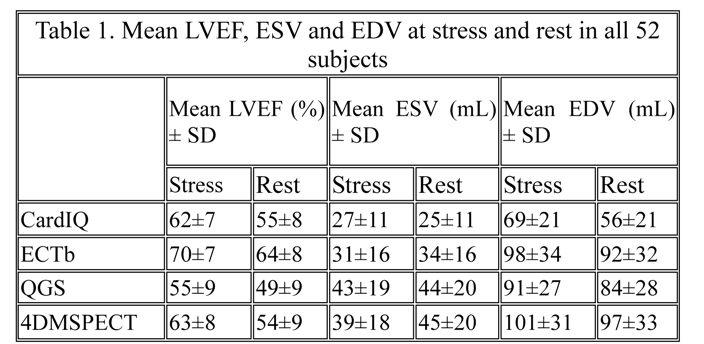Abstract
480
Objectives ECG-gating is increasingly utilized for 82Rb cardiac PET-CT, but normal ranges for global functional parameters have not been defined yet. We sought to establish normal values for left ventricular ejection fraction (LVEF), end systolic volume (ESV), and end diastolic volume (EDV) using four different commercial softwares. Additionally, we compared two different approaches for definition of a normal individual.
Methods Overall, 52 individuals who underwent gated myocardial perfusion PET/CT using 82Rb for clinical indications were included. Subgroup 1 consisted of 28 subjects with low pre-test probability for coronary artery disease (CAD) (<10%), and subgroup 2 of 24 subjects who had normal coronary CT angiography. LVEF, ESV, and EDV were calculated at rest and during dipyridamole-induced stress, using 4 different softwares: CardIQ Physio (a dedicated PET software), and the 3 major SPECT softwares Emory Cardiac Toolbox (ECTb), Quantitated Gated SPECT (QGS), and 4D-MSPECT.
Results Mean LVEF, ESV and EDV at stress and rest were not different between subgroups 1 and 2 (p>0.05). However, there were significant differences for mean LVEF, ESV and EDV between softwares (Table 1). LVEF was comparable only for CardIQ and 4D-MSPECT (p 0.204 and 0.902 at stress and rest respectively), while ECTB yielded higher (p<0.05), and QGS lower values (p<0.05).
Conclusions The normal range of LVEF and volumes from gated 82Rb PET-CT varies significantly between softwares, and therefore cannot be used interchangeably. Definition of normal subjects by a low pre-test probability for CAD or a normal coronary CTA yields comparable results.

- © 2009 by Society of Nuclear Medicine






